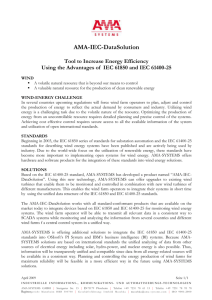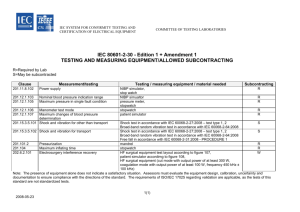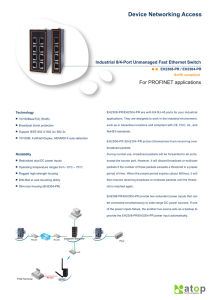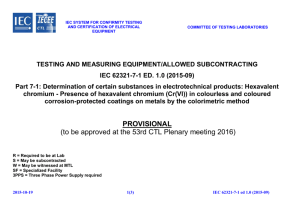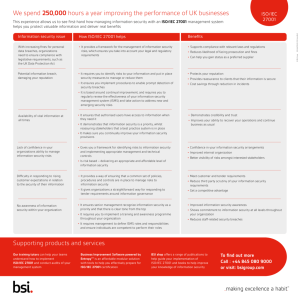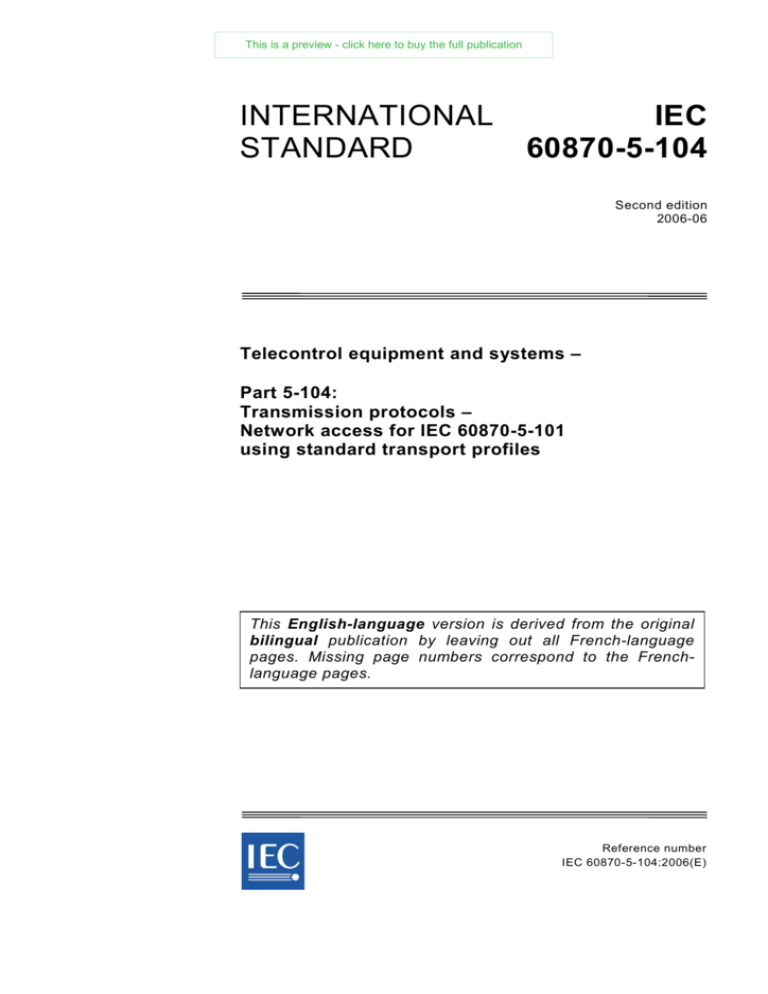
This is a preview - click here to buy the full publication
INTERNATIONAL
STANDARD
IEC
60870-5-104
Second edition
2006-06
Telecontrol equipment and systems –
Part 5-104:
Transmission protocols –
Network access for IEC 60870-5-101
using standard transport profiles
This English-language version is derived from the original
bilingual publication by leaving out all French-language
pages. Missing page numbers correspond to the Frenchlanguage pages.
Reference number
IEC 60870-5-104:2006(E)
This is a preview - click here to buy the full publication
INTERNATIONAL
STANDARD
IEC
60870-5-104
Second edition
2006-06
Telecontrol equipment and systems –
Part 5-104:
Transmission protocols –
Network access for IEC 60870-5-101
using standard transport profiles
IEC 2006 Copyright - all rights reserved
No part of this publication may be reproduced or utilized in any form or by any means, electronic or mechanical,
including photocopying and microfilm, without permission in writing from the publisher.
International Electrotechnical Commission, 3, rue de Varembé, PO Box 131, CH-1211 Geneva 20, Switzerland
Telephone: +41 22 919 02 11 Telefax: +41 22 919 03 00 E-mail: inmail@iec.ch Web: www.iec.ch
Commission Electrotechnique Internationale
International Electrotechnical Com m ission
Международная Электротехническая Комиссия
PRICE CODE
XB
For price, see current catalogue
This is a preview - click here to buy the full publication
60870-5-104 IEC:2006
–3–
CONTENTS
FOREWORD...........................................................................................................................9
INTRODUCTION................................................................................................................... 13
1
Scope and object............................................................................................................ 15
2
Normative references ..................................................................................................... 15
3
General architecture ....................................................................................................... 17
4
Protocol structure ........................................................................................................... 21
5
Definition of Application Protocol Control Information (APCI) .......................................... 23
6
5.1 Protection against loss and duplication of messages ............................................. 29
5.2 Test procedures .................................................................................................... 33
5.3 Transmission control using Start/Stop ................................................................... 37
5.4 Portnumber ........................................................................................................... 45
5.5 Maximum number of outstanding I format APDUs (k)............................................. 45
Selection of ASDUs defined in IEC 60870-5-101 and additional ASDUs ......................... 45
7
Mapping of selected application data units and functions to the TCP services ................ 53
8
7.1 Station initialization (6.1.5 to 6.1.7 of IEC 60870-5-5)............................................ 53
7.2 Data acquisition by polling (6.2 of IEC 60870-5-5) ................................................. 63
7.3 Cyclic data transmission (6.3 of IEC 60870-5-5) .................................................... 63
7.4 Acquisition of events (6.4 of IEC 60870-5-5) ......................................................... 63
7.5 General interrogation (6.6 of IEC 60870-5-5) ......................................................... 63
7.6 Clock synchronization (6.7 of IEC 60870-5-5) ........................................................ 65
7.7 Command transmission (6.8 of IEC 60870-5-5) ..................................................... 67
7.8 Transmission of integrated totals (6.9 of IEC 60870-5-5) ....................................... 69
7.9 Parameter loading (6.10 of IEC 60870-5-5) ........................................................... 69
7.10 Test procedure (6.11 of IEC 60870-5-5) ................................................................ 71
7.11 File transfer (6.12 of IEC 60870-5-5) Control and monitor direction ....................... 71
ASDUs for process information in control direction with time tag .................................... 73
8.1
8.2
8.3
8.4
8.5
8.6
8.7
8.8
8.9
TYPE IDENT 58: C_SC_TA_1 Single command with time tag CP56Time2a ........... 75
TYPE IDENT 59: C_DC_TA_1 Double command with time tag CP56Time2a ......... 77
TYPE IDENT 60: C_RC_TA_1 Regulating step command with time tag
CP56Time2a ......................................................................................................... 79
TYPE IDENT 61: C_SE_TA_1 Set-point command with time tag CP56Time2a,
normalized value ................................................................................................... 81
TYPE IDENT 62: C_SE_TB_1 Set-point command with time tag CP56Time2a,
scaled value .......................................................................................................... 83
TYPE IDENT 63: C_SE_TC_1 Set-point command with time tag CP56Time2a,
short floating point number .................................................................................... 85
TYPE IDENT 64: C_BO_TA_1 Bitstring of 32 bit with time tag CP56Time2a .......... 87
TYPE IDENT 107: C_TS_TA_1 Test command with time tag CP56Time2a ............ 89
TYPE IDENT 127: F_SC_NB_1 QueryLog – Request archive file .......................... 91
This is a preview - click here to buy the full publication
60870-5-104 IEC:2006
9
–5–
Interoperability ............................................................................................................... 93
9.1 System or device ................................................................................................... 93
9.2 Network configuration............................................................................................ 93
9.3 Physical layer ........................................................................................................ 95
9.4 Link layer .............................................................................................................. 95
9.5 Application layer.................................................................................................... 97
9.6 Basic application functions .................................................................................. 107
10 Redundant connections ................................................................................................ 115
10.1
10.2
10.3
10.4
10.5
10.6
10.7
General ............................................................................................................... 115
General requirements .......................................................................................... 115
Initialisation of controlling station ........................................................................ 119
Initialisation of controlled station ......................................................................... 123
User data from controlling station ........................................................................ 127
User data from controlled station ......................................................................... 131
State transition diagrams..................................................................................... 135
Figure 1 – General architecture (example) ............................................................................ 19
Figure 2 – Selected standard provisions of the defined telecontrol companion standard........ 21
Figure 3 – Selected standard provisions of the TCP/IP protocol suite RFC 2200
(example) ............................................................................................................................. 23
Figure 4 – APDU of the defined telecontrol companion standard ........................................... 25
Figure 5 – APCI of the defined telecontrol companion standard ............................................ 25
Figure 6 – Control field of type Information transfer format (I format) .................................... 27
Figure 7 – Control field of type numbered supervisory functions (S format) ........................... 27
Figure 8 – Control field of type unnumbered control functions (U format) .............................. 27
Figure 9 – Undisturbed sequences of numbered I format APDUs .......................................... 29
Figure 10 – Undisturbed sequences of numbered I format APDUs acknowledged by an
S format APDU ..................................................................................................................... 31
Figure 11 – Disturbed sequence of numbered I format APDUs .............................................. 31
Figure 12 – Time-out in case of a not acknowledged last I format APDU ............................... 33
Figure 13 – Undisturbed test procedure ................................................................................ 35
Figure 14 – Unconfirmed test procedure ............................................................................... 35
Figure 15 – Start data transfer procedure ............................................................................. 37
Figure 16 – Stop data transfer procedure .............................................................................. 39
Figure 17 – State transition diagram for Start/Stop procedure (controlled station) ................. 41
Figure 18 – State transition diagram for Start/Stop procedure (controlling station) ................ 43
Figure 19 – TCP connection establishment and close ........................................................... 55
Figure 20 – Initialization of the controlling station ................................................................. 57
Figure 21 – Local initialization of the controlled station ......................................................... 59
Figure 22 – Remote initialization of the controlled station ..................................................... 61
Figure 23 – ASDU: C_SC_TA_1 Single command with time tag CP56Time2a ....................... 75
Figure 24 – ASDU: C_DC_TA_1 Double command with time tag CP56Time2a ...................... 77
Figure 25 – ASDU: C_RC_TA_1 Regulating step command with time tag CP56Time2a ........ 79
This is a preview - click here to buy the full publication
60870-5-104 IEC:2006
–7–
Figure 26 – ASDU: C_SE_TA_1 Set-point command with time tag CP56Time2a,
normalized value................................................................................................................... 81
Figure 27 – ASDU: C_SE_TB_1 Set-point command with time tag CP56Time2a, scaled
value .................................................................................................................................... 83
Figure 28 – ASDU: C_SE_TC_1 Set-point command with time tag CP56Time2a, short
floating point number ............................................................................................................ 85
Figure 29 – ASDU: C_BO_TA_1 Bitstring of 32 bit with time tag CP56Time2a ...................... 87
Figure 30 – ASDU: C_TS_TA_1 Test command with time tag CP56Time2a .......................... 89
Figure 31 – ASDU: F_SC_NB_1 QueryLog – Request archive file ......................................... 91
Figure 32 – Initialisation of controlling station with redundant connections .......................... 121
Figure 33 – Initialisation of controlled station with redundant connections ........................... 125
Figure 34 – Redundant connections – User data from controlling station ............................ 129
Figure 35 – Redundant connections – User data from controlled station ............................. 133
Figure 36 – State transition diagram for redundant connections (controlled station) ............ 137
Figure 37 – State transition diagram for redundant connections (controlling station) ........... 139
Table 1 – Process information in monitor direction ................................................................ 47
Table 2 – Process information in control direction ................................................................. 49
Table 3 – System information in monitor direction ................................................................. 51
Table 4 – System information in control direction .................................................................. 51
Table 5 – Parameter in control direction................................................................................ 51
Table 6 – File transfer ........................................................................................................... 51
This is a preview - click here to buy the full publication
60870-5-104 IEC:2006
–9–
INTERNATIONAL ELECTROTECHNICAL COMMISSION
____________
TELECONTROL EQUIPMENT AND SYSTEMS –
Part 5-104: Transmission protocols –
Network access for IEC 60870-5-101 using
standard transport profiles
FOREWORD
1) The International Electrotechnical Commission (IEC) is a worldwide organization for standardization comprising
all national electrotechnical committees (IEC National Committees). The object of IEC is to promote
international co-operation on all questions concerning standardization in the electrical and electronic fields. To
this end and in addition to other activities, IEC publishes International Standards, Technical Specifications,
Technical Reports, Publicly Available Specifications (PAS) and Guides (hereafter referred to as “IEC
Publication(s)”). Their preparation is entrusted to technical committees; any IEC National Committee interested
in the subject dealt with may participate in this preparatory work. International, governmental and nongovernmental organizations liaising with the IEC also participate in this preparation. IEC collaborates closely
with the International Organization for Standardization (ISO) in accordance with conditions determined by
agreement between the two organizations.
2) The formal decisions or agreements of IEC on technical matters express, as nearly as possible, an international
consensus of opinion on the relevant subjects since each technical committee has representation from all
interested IEC National Committees.
3) IEC Publications have the form of recommendations for international use and are accepted by IEC National
Committees in that sense. While all reasonable efforts are made to ensure that the technical content of IEC
Publications is accurate, IEC cannot be held responsible for the way in which they are used or for any
misinterpretation by any end user.
4) In order to promote international uniformity, IEC National Committees undertake to apply IEC Publications
transparently to the maximum extent possible in their national and regional publications. Any divergence
between any IEC Publication and the corresponding national or regional publication shall be clearly indicated in
the latter.
5) IEC provides no marking procedure to indicate its approval and cannot be rendered responsible for any
equipment declared to be in conformity with an IEC Publication.
6) All users should ensure that they have the latest edition of this publication.
7) No liability shall attach to IEC or its directors, employees, servants or agents including individual experts and
members of its technical committees and IEC National Committees for any personal injury, property damage or
other damage of any nature whatsoever, whether direct or indirect, or for costs (including legal fees) and
expenses arising out of the publication, use of, or reliance upon, this IEC Publication or any other IEC
Publications.
8) Attention is drawn to the Normative references cited in this publication. Use of the referenced publications is
indispensable for the correct application of this publication.
9) Attention is drawn to the possibility that some of the elements of this IEC Publication may be the subject of
patent rights. IEC shall not be held responsible for identifying any or all such patent rights.
International Standard IEC 60870-5-104 Ed.2 has been prepared by IEC
committee 57: Power systems management and associated information exchange.
technical
This second edition cancels and replaces the first edition published in 2000 and constitutes a
technical revision. The main changes of this second edition with respect to the previous
edition are as follows: improvement of the sequences and interoperability of the protocol and
addition of new functions for the handling of redundant connections.
This is a preview - click here to buy the full publication
60870-5-104 IEC:2006
– 11 –
The text of this standard is based on the following documents:
FDIS
Report on voting
57/812/FDIS
57/819/RVD
Full information on the voting for the approval of this standard can be found in the report on
voting indicated in the above table.
This publication has been drafted in accordance with the ISO/IEC directives, Part 2.
IEC 60870-5 consists of the following parts, under the general title Telecontrol equipment and
systems – Part 5: Transmission protocols
Part 5:
Transmission protocols – Section One: Transmission frame formats
Part 5:
Transmission protocols – Section 2: Link transmission procedures
Part 5:
Transmission protocols – Section 3: General structure of application data
Part 5:
Transmission protocols – Section 4: Definition and coding of application
information elements
Part 5:
Transmission protocols – Section 5: Basic application functions
Part 5-6:
Guidelines for conformance testing for the IEC 60870-5 companion standards
Part 5-101:
Transmission protocols – Companion standard for basic telecontrol tasks
Part 5:
Transmission protocols – Section 102: Companion
transmission of integrated totals in electric power systems
Part 5-103:
Transmission protocols – Companion standard for the informative interface of
protection equipment
Part 5-104:
Transmission protocols – Network access for IEC 60870-5-101 using standard
transport profiles
Part 5-601:
Conformance test cases for the IEC 60870-5-101 companion standard
standard
for
the
The committee has decided that the contents of this publication will remain unchanged until
the maintenance result date indicated on the IEC web site under "http://webstore.iec.ch" in
the data related to the specific publication. At this date, the publication will be
•
•
•
•
reconfirmed;
withdrawn;
replaced by a revised edition, or
amended.
This is a preview - click here to buy the full publication
60870-5-104 IEC:2006
– 13 –
INTRODUCTION
IEC 60870-5-101 provides a communication profile for sending basic telecontrol messages
between a central telecontrol station and telecontrol outstations, which uses permanent
directly connected data circuits between the central station and individual outstations.
In some applications, it may be required to send the same types of application messages
between telecontrol stations using a data network containing relay stations which store and
forward the messages and provide only a virtual circuit between the telecontrol stations. This
type of network delays messages by varying amounts of time depending on the network traffic
load.
In general, the variable message delay times mean that it is not possible to use the link layer
as defined in IEC 60870-5-101 between telecontrol stations. However, in some cases it is
possible to connect telecontrol stations having all three layers of the companion standard
IEC 60870-5-101 to suitable data networks using Packet Assembler Disassembler (PAD) type
stations to provide access for balanced communication.
In all other cases this companion standard, which does not use the link functions of
IEC 60870-5-101, may be used to provide balanced access via a suitable transport profile.
This is a preview - click here to buy the full publication
60870-5-104 IEC:2006
– 15 –
TELECONTROL EQUIPMENT AND SYSTEMS –
Part 5-104: Transmission protocols –
Network access for IEC 60870-5-101 using
standard transport profiles
1
Scope and object
This part of IEC 60870 applies to telecontrol equipment and systems with coded bit serial data
transmission for monitoring and controlling geographically widespread processes. It defines a
telecontrol companion standard that enables interoperability among compatible telecontrol
equipment. The defined telecontrol companion standard utilizes standards of the IEC 60870-5
series. The specifications of this part present a combination of the application layer of
IEC 60870-5-101 and the transport functions provided by a TCP/IP (Transmission Control
Protocol/Internet Protocol). Within TCP/IP, various network types can be utilized, including
X.25, FR (Frame Relay), ATM (Asynchronous Transfer Mode) and ISDN (Integrated Service
Data Network). Using the same definitions, alternative ASDUs (Application Service Data Unit)
as specified in other IEC 60870-5 companion standards (for example, IEC 60870-5-102) may
be combined with TCP/IP, but this is not described further in this part.
NOTE
2
Security mechanisms are outside the scope of this standard.
Normative references
The following referenced documents are indispensable for the application of this document.
For dated references, only the edition cited applies. For undated references, the latest edition
of the referenced document (including any amendments) applies.
IEC 60870-5-3:1992, Telecontrol equipment and systems – Part 5: Transmission protocols –
Section 3: General structure of application data
IEC 60870-5-4:1993, Telecontrol equipment and systems – Part 5: Transmission protocols –
Section 4: Definition and coding of application information elements
IEC 60870-5-5:1995, Telecontrol equipment and systems – Part 5: Transmission protocols –
Section 5: Basic application functions
IEC 60870-5-101:2003, Telecontrol equipment and systems – Part 5-101: Transmission
protocols – Companion standard for basic telecontrol tasks
IEC 60870-5-102:1996, Telecontrol equipment and systems – Part 5: Transmission protocols
– Section 102: Companion standard for the transmission of integrated totals in electric power
systems
ITU-T Recommendation X.25:1996, Interface between Data Terminal Equipment (DTE) and
Data Circuit-terminating Equipment (DCE) for terminals operating in the packet mode and
connected to public data networks by dedicated circuit
IEEE 802.3:1998, Information technology – Telecommunications and information exchange
between systems – Local and metropolitan area networks – Specific requirements – Part 3:
Carrier sense multiple access with collision detection (CSMA/CD) access method and
physical layer specifications
This is a preview - click here to buy the full publication
60870-5-104 IEC:2006
– 17 –
RFC 791, Internet Protocol, Request for Comments 791 (MILSTD 1777) (September, 1981)
RFC 793, Transmission Control Protocol, Request for Comments 793 (MILSTD 1778)
(September, 1981)
RFC 894, Internet Protocol on Ethernet Networks
RFC 1661, Point-to-Point Protocol (PPP)
RFC 1662, PPP in HDLC Framing
RFC 1700, Assigned Numbers, Request for Comments 1700 (STD 2) (October, 1994)
RFC 2200, Internet Official Protocol Standards, Request for Comments 2200 (June, 1997)
3
General architecture
This standard defines the use of an open TCP/IP-interface to a network, containing for
example a LAN for telecontrol equipment, which transports IEC 60870-5-101 ASDUs. Routers
which include the different WAN-types (for example, X.25, Frame Relay, ISDN, etc.) may be
connected via a common TCP/IP-LAN-interface (see figure 1). Figure 1 shows a redundant
configuration in the central station in addition to a non-redundant system.
Motivations:
The use of separate routers offers the following advantages.
–
There is no need for network-specific software in end systems.
–
There is no need for routing functionality in end systems.
–
There is no need for network management in end systems.
–
It facilitates obtaining end systems from manufacturers that specialize in telecontrol
equipment.
–
It facilitates obtaining individual separate routers, to suit a variety of networks from
manufacturers specializing in this non-telecontrol specific field.
–
It is possible to change the network type by replacing only the router type, without
affecting the end systems.
–
It is particularly suitable
IEC 60870-5-101.
–
It is suitable for present and future implementations.
for
converting
existing
end
systems
that
conform
to


